Effects of modifiable prehospital factors on survival after out-of-hospital cardiac arrest in rural versus urban areas
- PMID: 29669574
- PMCID: PMC5907488
- DOI: 10.1186/s13054-018-2017-x
Effects of modifiable prehospital factors on survival after out-of-hospital cardiac arrest in rural versus urban areas
Abstract
Background: The modifiable prehospital system factors, bystander cardiopulmonary resuscitation (CPR), emergency medical services (EMS), response time, and EMS physician attendance, may affect short- and long-term survival for both rural and urban out-of-hospital cardiac arrest (OHCA) patients. We studied how such factors influenced OHCA survival in a mixed urban/rural region with a high survival rate after OHCA.
Methods: We analyzed the association between modifiable prehospital factors and survival to different stages of care in 1138 medical OHCA patients from an Utstein template-based cardiac arrest registry, using Kaplan-Meier type survival curves, univariable and multivariable logistic regression and mortality hazard plots.
Results: We found a significantly higher probability for survival to hospital admission (OR: 1.84, 95% CI 1.43-2.36, p < 0.001), to hospital discharge (OR: 1.51, 95% CI 1.08-2.11, p = 0.017), and at 1 year (OR: 1.58, 95% CI 1.11-2.26, p = 0.012) in the urban group versus the rural group. In patients receiving bystander CPR before EMS arrival, the odds of survival to hospital discharge increased more than threefold (OR: 3.05, 95% CI 2.00-4.65, p < 0.001). However, bystander CPR was associated with increased patient survival to discharge only in urban areas (survival probability 0.26 with CPR vs. 0.08 without CPR, p < 0.001). EMS response time ≥ 10 min was associated with decreased survival (OR: 0.61, 95% CI 0.45-0.83, p = 0.002), however, only in urban areas (survival probability 0.15 ≥ 10 min vs. 0.25 < 10 min, p < 0.001). In patients with prehospital EMS physician attendance, no significant differences were found in survival to hospital discharge (OR: 1.37, 95% CI 0.87-2.16, p = 0.17). In rural areas, patients with EMS physician attendance had an overall better survival to hospital discharge (survival probability 0.17 with EMS physician vs. 0.05 without EMS physician, p = 0.019). Adjusted for modifiable factors, the survival differences remained.
Conclusions: Overall, OHCA survival was higher in urban compared to rural areas, and the effect of bystander CPR, EMS response time and EMS physician attendance on survival differ between urban and rural areas. The effect of modifiable factors on survival was highest in the prehospital stage of care. In patients surviving to hospital admission, there was no significant difference in in-hospital mortality or in 1 year mortality between OHCA in rural versus urban areas.
Keywords: Cardiopulmonary resuscitation; Out-of-hospital cardiac arrest; Rural; Survival; Urban.
Conflict of interest statement
Ethics approval and consent to participate
The Utstein template database was nationally and locally approved for scientific purposes by the Regional committee for Research Ethics and the Institutional Review Board at Stavanger Hospital Trust, Norway, respectively. Patient’s informed consent was not considered necessary for this study to be approved as the purpose for the analysis of the data collection was for quality management.
Consent for publication
Not applicable.
Competing interests
WTM is employed with financial support by The Norwegian Air Ambulance Foundation.
CAB is employed by the Regional Competence Center for Acute Medicine in western Norway (RAKOS) with financial support from the Norwegian Directorate of Health. He has participated in Global Resuscitation Alliance meetings sponsored by the Laerdal Foundation for Acute Medicine, TrygFonden and EMS2017.
The authors declare that they have no competing interests.
Publisher’s Note
Springer Nature remains neutral with regard to jurisdictional claims in published maps and institutional affiliations.
Figures
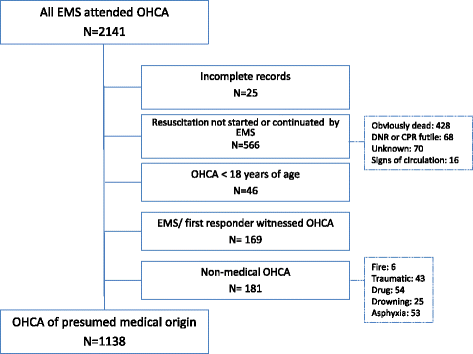
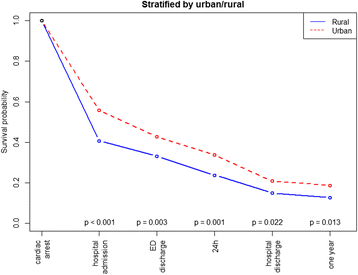

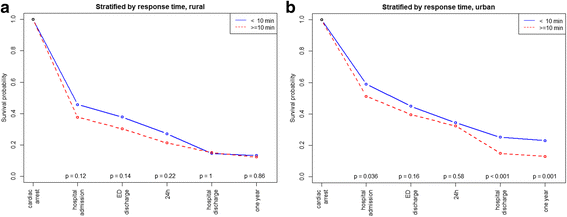
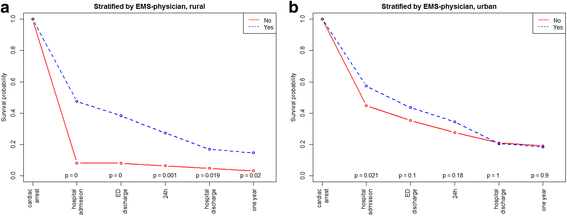
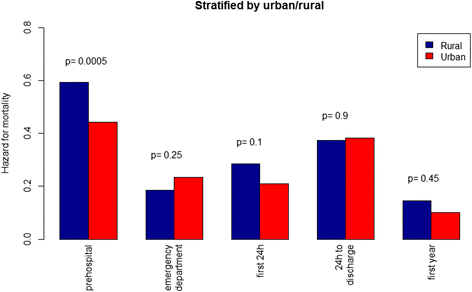
Similar articles
-
Out-of-hospital cardiac arrest surveillance --- Cardiac Arrest Registry to Enhance Survival (CARES), United States, October 1, 2005--December 31, 2010.MMWR Surveill Summ. 2011 Jul 29;60(8):1-19. MMWR Surveill Summ. 2011. PMID: 21796098
-
Association between prehospital prognostic factors and out-of-hospital cardiac arrest: Effect of rural-urban disparities.Am J Emerg Med. 2021 Aug;46:456-461. doi: 10.1016/j.ajem.2020.10.054. Epub 2020 Oct 27. Am J Emerg Med. 2021. PMID: 33143958
-
Impact of cardiopulmonary resuscitation duration on survival from paramedic witnessed out-of-hospital cardiac arrests: An observational study.Resuscitation. 2016 Mar;100:25-31. doi: 10.1016/j.resuscitation.2015.12.011. Epub 2016 Jan 13. Resuscitation. 2016. PMID: 26774172
-
When is a Cardiac Arrest Non-Cardiac?Prehosp Disaster Med. 2017 Oct;32(5):523-527. doi: 10.1017/S1049023X17006446. Epub 2017 May 2. Prehosp Disaster Med. 2017. PMID: 28463098 Review.
-
The global survival rate among adult out-of-hospital cardiac arrest patients who received cardiopulmonary resuscitation: a systematic review and meta-analysis.Crit Care. 2020 Feb 22;24(1):61. doi: 10.1186/s13054-020-2773-2. Crit Care. 2020. PMID: 32087741 Free PMC article.
Cited by
-
Ambulance nurses' experiences as the sole caregiver with critical patients during long ambulance transports: an interview study.Scand J Trauma Resusc Emerg Med. 2024 Jan 23;32(1):6. doi: 10.1186/s13049-024-01178-1. Scand J Trauma Resusc Emerg Med. 2024. PMID: 38263118 Free PMC article.
-
Association of Degree of Urbanization and Survival in Out-of-Hospital Cardiac Arrest.J Am Heart Assoc. 2023 May 16;12(10):e8322. doi: 10.1161/JAHA.122.028449. Epub 2023 May 9. J Am Heart Assoc. 2023. PMID: 37158087 Free PMC article.
-
Helicopter Emergency Medical Service (HEMS) Response in Rural Areas in Poland: Retrospective Study.Int J Environ Res Public Health. 2019 Apr 30;16(9):1532. doi: 10.3390/ijerph16091532. Int J Environ Res Public Health. 2019. PMID: 31052200 Free PMC article.
-
Out-of-hospital cardiac arrest outcomes' determinants: an Italian retrospective cohort study based on Lombardia CARe.Intern Emerg Med. 2024 Oct;19(7):2035-2045. doi: 10.1007/s11739-024-03573-z. Epub 2024 Mar 28. Intern Emerg Med. 2024. PMID: 38548967 Free PMC article.
-
Development of unmanned aerial vehicle (UAV) networks delivering early defibrillation for out-of-hospital cardiac arrests (OHCA) in areas lacking timely access to emergency medical services (EMS) in Germany: a comparative economic study.BMJ Open. 2021 Jan 22;11(1):e043791. doi: 10.1136/bmjopen-2020-043791. BMJ Open. 2021. PMID: 33483448 Free PMC article.
References
MeSH terms
LinkOut - more resources
Full Text Sources
Other Literature Sources

